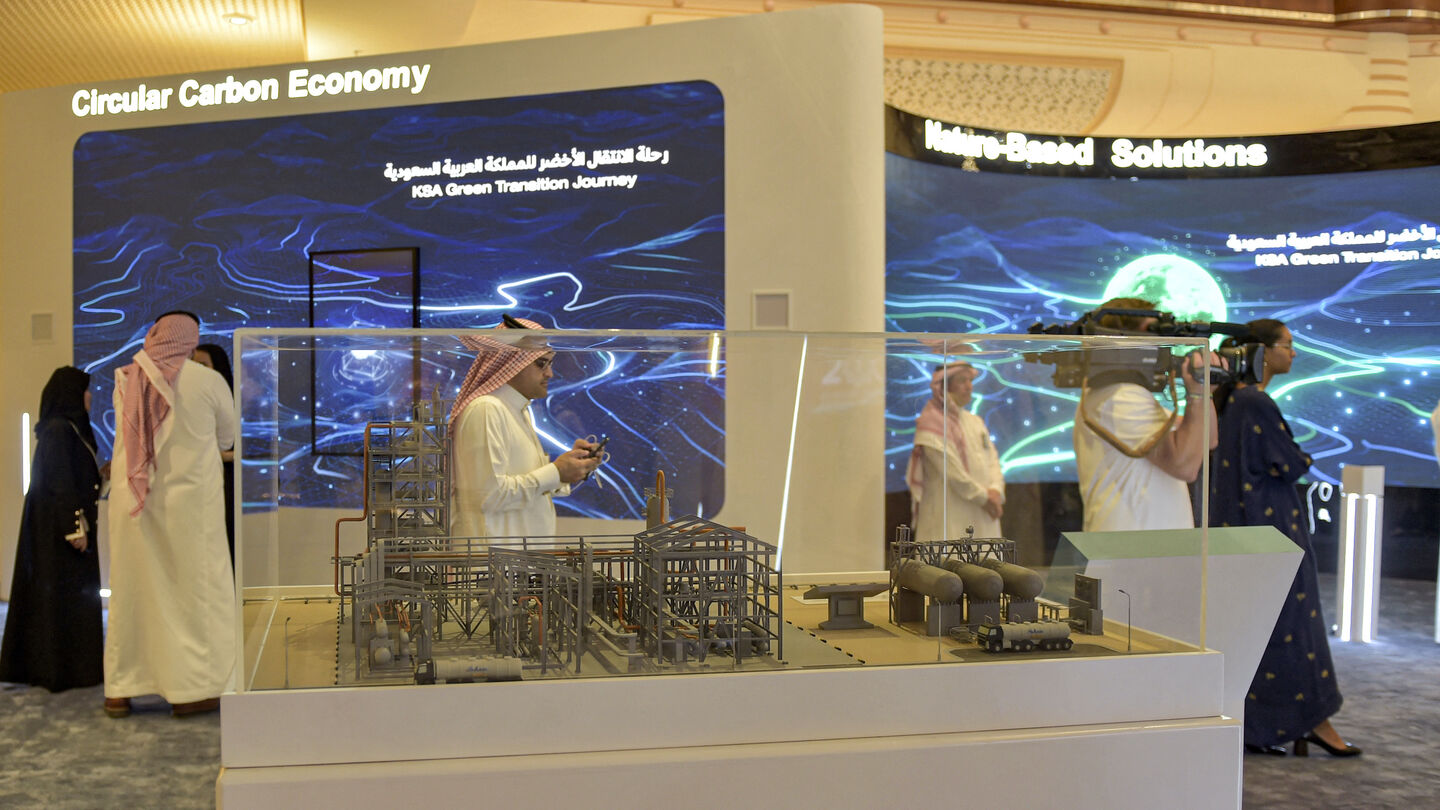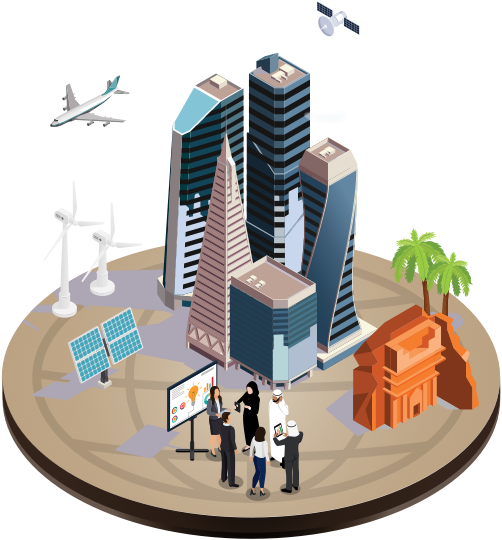
From fields to clouds: the Middle East's bid for the digital economy
April 2023 Al-Monitor PRO Trend Report
3540 words
Introduction
Glimpses of the frenetic activity of the tech industry in the Middle East are becoming all the more common as countries in the region move forward with their plans to foster the development of their digital economies.
Egyptian super-app MNT-Halan, which provides everything from fintech to delivery and ride-hailing services, announced in February that it was on course to becoming the latest unicorn in the Middle East as it approached a valuation of over $1 billion.
A couple of weeks later, the Egyptian investment management firm El Sewedy Capital and the Emirati data center space provider Gulf Data Hub signed an MoU to invest $2.1 billion in the construction of three data complexes in Egypt that together would form Africa’s largest data center.
During the global tech event Leap 2023 in Riyadh that took place in February, Saudi Arabia announced it has locked in investments worth over $9 billion from tech giants in sectors such as fintech and the Internet of Things.
Last but not least, Emirati telecom operator Du signed an MoU with China’s giant Huawei at the Mobile World Congress (MWC) in Barcelona to strengthen cooperation in the development of 6G technology and innovation in 5.5G.
All these announcements made during February alone reveal the region’s efforts to capitalize on the massive long-term upside of the digital economy. A recent study by the World Bank (WB) estimated that, if universal adoption of digital technologies was achieved, GDP per capita in the MENA region could grow by more than 40%, frictional unemployment could be virtually eliminated, and female labor participation could almost double. But to reach these figures, governments will have to face equally daunting challenges, especially in the fields of infrastructure, human capital and governance.
“Like other general-purpose technologies such as electricity, telephones and railroads, digital-economy technologies are usable across all sectors and boost economic connectivity, whether physical or virtual,” Christina Wood, a WB senior economist and co-author of the aforementioned report, told Al-Monitor. “As more people use them, the more useful the technologies become, and hence the higher their impact,” she added.
1. State of Play: MENA’s digital economy
Digital economy is a broad concept that cuts across sectors and applies to both goods and services, the production process and transactions. The EU research agency Eurofound states that there is no official definition, but notes that the digital economy “encompasses businesses that sell goods and services via the internet, and digital platforms that connect spare capacity and demand.” Digital economy is also associated with the Fourth Industrial Revolution, or "Industry 4.0," which is focused on greater automation, interconnectivity and integration of cutting-edge digital solutions into production and supply networks.
The MENA region is considered fertile ground for the expansion of digital economies thanks in part to the commitment of regional governments and its young and tech-savvy population that has become one of fastest adopters of digital technologies in the world.
The International Telecommunication Union (ITU), a UN agency, estimates that in 2022 internet usage in Arab countries reached 70%. The percentage of people owning a phone last year was 81%, compared to a world average of 73%. The share of those with an active mobile-broadband subscription in the region stood at 74%, below the 87% world average.
Building on this, a growing number of businesses and consumers in the region have moved into or have increased their presence in the digital economy over the past years. Consulting firm RedSeer estimated that in 2022 MENA’s consumer spending on products and services that were digitally ordered or delivered stood at about $100 billion, and it anticipates that by 2027
the figure, which excludes IT infrastructure, will top $250 billion.
Funding for tech startups in the region in 2022 also kept its upward trend and topped $3 billion despite the global economic turmoil, according to startup data firm Magnitt, which noted that the number of international investors entering the region is on the rise as well.
The development of the digital economy in the Middle East, however, is very uneven, largely due to the wide digital divide that exists among three main groups of countries.
The first, comprising high-income GCC countries, is firmly on the lead, having developed ambitious state-led digital transformation "Vision" plans and boasting some of the world’s highest mobile penetration and broadband connectivity rates.
According to the Swedish telco multinational Ericsson, smartphone penetration in these countries stood at 82% in 2020, second only to Northeast Asia. Monthly data traffic per smartphone was in turn the world’s highest, exceeding 18 GB. And a recent survey by the consulting firm McKinsey found that the number of sectors, such as banking and telecoms, digitally accessed by consumers in these countries is among the largest in the world.
“While there may be some variations in the level of digital economy development among the GCC countries, they are all making efforts to invest in digital infrastructure, promote innovation, and transform their economies in the digital era,” Nidal Abou Zaki, managing director at Orient Planet Group, a consultancy firm in Dubai, told Al-Monitor.
The only place in the region outside the Gulf that is also on the lead in digital economy is Israel, where internet penetration in 2021 was 92.5%, higher than the OECD average of 91.5%. The country also has almost 140 mobile broadband subscriptions per 100 inhabitants and 28.2% fixed broadband subscriptions, according to data from the OECD.
Despite these figures, only 14% of Israel’s small businesses were making e-commerce sales in 2020, and just 62% of the country’s companies had an online website, both numbers considerably below the OECD average of 26% and 78% respectively.
The second group, comprising middle-income countries such as Egypt, Tunisia, Jordan and Morocco, is trying to pick up the pace encouraged by the high growth and job creation prospects. But compared to their neighbors in the Gulf, these nations face significant accessibility and affordability gaps, particularly in rural areas and among low-income populations and women. They also have limited infrastructure, largely because their investment capacity is far lower, and concerns about internet security remain high.
In these countries, the digital economy is still emerging, but some are expected to register the highest relative growth in the region in the coming years, especially in more mature sectors such as e-commerce, as they come from a lower base than high-income countries.
The nation in this group that draws the most interest is Egypt, which is by far the region’s most populous. “Egypt is a very important case partly because it is not a rich energy exporter [and] has a vast population. Here we can really see and study the impact of digital economy on a much broader scale than, for example, in the UAE,” Manuel Langendorf, a researcher and consultant on digital transformation in the MENA region, told Al-Monitor.
The third and last group comprises low-income countries or countries in conflict, such as Palestine, Syria and Yemen, where the lack of infrastructure is much more acute, challenges of connectivity and accessibility are more basic, the digital gaps across social groups are even deeper, and mistrust toward the use of digital technologies is prevalent.
2. Leading sectors
One of the most mature and best performing sectors of the digital economy in the MENA region is e-commerce. Prior to the pandemic, the GCC and Egypt accounted for about 80% of the region’s e-commerce market and were growing twice as fast as the rest of the region, according to a study by Google and research firm Brain Company. Assessing the current value of the region’s e-commerce is difficult because of differences in methodology, but most estimates put it between $30 billion and $50 billion.
The rates at which e-commerce is growing at a national level vary widely, according to e-commerce operational hub EZDubai. The UAE, Saudi Arabia and Israel, where digital economy is more advanced, have in recent years accounted for the largest contribution to the region’s e-commerce growth in absolute terms, while less developed markets such as Egypt, Lebanon and Algeria have seen faster relative growth starting from a smaller base.
Another sector that benefits most from the adoption of digital technologies is tourism, as increased internet penetration is associated with lower costs of searching, planning and taking trips, which in turn increases demand. RedSeer estimated that in 2022 tourism accounted for around a quarter of the digital economy in the MENA region.
A third high-performing sector of the region’s digital economy is fintech, which is thriving fueled by the high percentage of unbanked population and the creation of a conducive environment for its development, including friendly regulations. According to global data platform DealRoom, there are currently more than 800 fintech startups in the MENA region, with a combined value of over $15 billion. The countries where fintech is most advanced are the GCC countries and Egypt.
Among the sectors that are set to grow the most in the next few years, especially in those countries that are already now at an advanced stage of development of digital economies, is healthtech. According to DealRoom, the ecosystem of healthtech startups in the MENA region is currently worth over $1.5 billion, 22 times more than in 2016. Since that year, healthtech startups have raised over $200 million in VC funding. Here, too, the countries that have seen the largest investments include the GCC countries and Israel.
Another sector that is also expected to be among the fastest growing in the region in the next few years is edtech. According to Jacobs Foundation, dedicated to evidence-based learning solutions, edtech spending in the Middle East currently stands at about $4 billion. Egypt, the UAE, Israel and Saudi Arabia are the largest markets, but smaller ones like Jordan and Tunisia have emerging ecosystems, according to the global data platform HolonIQ.
A sector that also characterizes the region’s digital economy is oil and gas, which in the Middle East has become a true digital player, particularly in the Gulf. By integrating cutting-edge digital solutions into the production process (such as artificial intelligence, the Internet of Things, robots and drones) oil giants are improving their efficiency, safety and performance. Two cases in point are the Saudi Aramco and the Emirati ADNOC.
Similarly, the GCC states are also among the countries in the world investing the most in the development of the new technologies of the Fourth Industrial Revolution, such as AI, blockchain, cloud, the Internet of Things and the industrial Internet of Things. The countries that have shown the greatest commitment to its development are the UAE, Saudi Arabia and Qatar, while the rest of the countries in the region are lagging behind.
3. 2023 Outlook
• The digital and tech investments made during the height of the pandemic could be put to the test in 2023, according to market intelligence provider International Data Corporation (IDC). In this context, IDC considers that further progress in the economy’s digital transformation, including in consumer experience and operations, will be key to better navigate the current global economic turmoil.
• At least during the first half (H1) of 2023, the use of digital channels among consumers in the Middle East will increase in the vast majority of sectors, according to McKinsey, which does not anticipate a similar growth in other markets like Europe.
• Consumer use of digital services across sectors in Egypt is projected to grow 8% in H1 2023 compared to H2 2022, according to McKinsey, while in Saudi Arabia and the UAE this figure is expected to stand at 3% and 4% respectively.
• The sectors that will concentrate the largest increase in digital use by consumers in the Middle East during H1 2023, compared to the previous six months, are insurance, travel, utilities and health care, according to McKinsey.
• Over the same period, the largest net spending growth among current sector users will be concentrated in edtech, fintech, tourism and e-commerce, with other sectors like healthtech and ride hailing following behind, according to RedSeer.
• Growth in high-income markets such as Saudi Arabia and the UAE will be driven in the short term primarily by emerging sectors such as edtech, healthtech and fintech, according to RedSeer. In middle-income nations like Egypt and Jordan, growth will come from both emerging and mature sectors, such as e-commerce.
• Fintech is set to grow fast in the region in the short-term as more people seek out innovative financial solutions, Abou Zaki said. “This could lead to new partnerships between traditional financial institutions and fintech startups, as well as increased investment in fintech research and development,” he anticipated.
• Other emerging sectors such as healthtech and edtech will also continue to grow. “In the short term, we can expect to see more health care providers investing in digital solutions to enhance patient experiences and improve outcomes,” Abou Zaki said. He added, “We can also expect to see immense growth in the education sector, with increased investment in digital education technologies to address the growing demand for online education and e-learning.”
• In the case of GCC countries, 2023 is again going to be a year marked by further advances and accelerated investment in new cutting-edge technologies, such as artificial intelligence, the Internet of Things, cloud infrastructure, data management and cybersecurity, according to the consulting firm Oliver Wyman.
• One of the key trends to observe is the continued integration of artificial intelligence in various sectors, Abou Zaki said. “With the massive development of new AI-based products and services, as well as increased investment in AI research, the technology will be the main engine of innovation in 2023,” he added.
• As the digital economy gathers pace, spending in tech infrastructure is also set to pick up, and IDC forecasts that spending on digital transformation will continue to rise in 2023 and top $48 billion in the Middle East, Türkiye and Africa (META) region. IDC projects that total ICT spending this year will exceed $230 billion.
• Overall, the digital economy in the MENA region will continue to face in 2023 many of the economic hurdles encountered in 2022, which could slow its growth. These include widespread high inflation, rising interest rates, volatility in demand, financing and currencies, and supply chains uncertainty, according to IDC.
4. Case Study: 5G
One of the so-called new technologies that is being deployed the fastest in parts of the Middle East is 5G. Proof of its rapid adoption is that in early March, Emirati telco etisalat by e& announced the launch of what it said is the MENA region’s first 5G standalone (SA) network, which will enable 5G connections to a fully 5G core network rather than having to rely on existing 4G infrastructure as is largely the case now.
As with the development of the digital economy more broadly, GCC countries are also leading the way in the MENA region when it comes to the adoption of 5G, which has become a top priority in their "Vision" strategies to diversify economies away from oil.
Some GCC nations are even rolling out ambitious plans, backed by massive investments, to integrate 5G technology not only into the digital infrastructure of major cities such as Riyadh, Doha and Dubai, but also into new smart cities under construction. Some of the most grandiose of these are the futuristic mega city of NEOM in Saudi Arabia, Masdar City in the UAE, Lusail in northern Qatar and the Duqm project in Oman.
The rest of the countries in the region lag considerably behind. And here, too, clear divides can be identified. In some middle-income countries like Egypt, Morocco, Jordan and Algeria, adoption of 3G and 4G has occurred only in the last few years. And these earlier technologies are expected to be dominant in the medium term alongside specific 5G pilot trials, according to predictions by the research firm Fitch Solutions.
In low-income nations or war-torn countries, such as Syria, Yemen and Iraq, where there are large gaps in infrastructure and services, as well as serious affordability issues, reliance on early generation technologies like 2G and 3G will prevail in the medium term.
One of the first sectors to adopt 5G is mobile telephony, which illustrates this regional gap well. 5G mobile subscriptions in the MENA region currently stand at around 24 million, while 4G amount to 430 million, or 56% of the total, according to the latest Mobility Report from Ericsson, the main provider of 5G network equipment in the United States.
By the end of 2028, Ericsson expects 5G subscriptions to have increased to 270 million, about 31% of the total, while it projects that 4G subscriptions will grow to 550 million and account for more than 60%. This growth will come mainly from the GCC countries, where Ericsson forecasts that 5G will account for about 73% of all mobile subscriptions by the end of 2026, with more than 60 million subscriptions.
One of the obstacles threatening to slow down this rapid rollout of 5G technology in the GCC countries, however, is the geopolitical tensions it raises between China and the United States. Many Gulf countries have made cooperation on the digital economy, including on 5G, one of the cornerstones of their relations with Beijing, but this development is causing unease in the United States, which has threatened to curb cooperation in strategic areas like defense.
“5G technologies represented the first manifestation of great decoupling between the US and China, as Washington pursued its Clean Network Initiative to limit the exposure of its allies and partners to Chinese technologies,” said Mohammed Soliman, director of the strategic technologies and cyber security program at the Middle East Institute (MEI).
“In the Gulf, similar to other regions, the US has been pushing governments to not rely on Huawei on the basis of national security. This has created tensions between Washington and its Gulf allies as the Gulf capitals do not share the same concerns and seek to preserve deep economic and technology ties to China,” Soliman told Al-Monitor.
5. Key Takeaways
• In the long run, the fundamentals for the digital economy to continue to expand in the MENA region are uneven but strong, and digital spending will keep rising as the deployment and penetration of new technologies keeps increasing and as a growing number of consumers and businesses turn to digital channels.
• A rising share of this growth is going to come from middle-income countries like Egypt, where the digital economy has a lot of room to expand, as compared to other more mature markets in the Gulf, which have driven growth so far and will nevertheless remain ahead in absolute terms.
• Millennial and Z generations will account for an increasing share of consumption, Sandeep Ganediwalla, managing partner at RedSeer Middle East, told Al-Monitor.
• Super apps, which offer different types of products and services in one platform, will become an increasingly important digital consumer channel. The consulting firm Gartner forecasts that by 2027, more than half of the global population will be active daily users of multiple super apps, which in turn will continue to expand the products and services that they provide.
• In the MENA region, super apps have the potential to dominate digital services and help drive financial inclusion, according to a 2021 study by Economist Impact. Oliver Wyman further anticipates that this model will be increasingly adopted in the public sector of GCC countries.
• New technologies such as AI, cloud, the internet of things and 5G will become more central, especially in the GCC countries. Consulting firm Accenture projects that sectors such as manufacturing, oil and gas, health care, banking and retail will embrace these emerging technologies more robustly over the next three to five years.
• These advances will come on the back of increasing spending on the development and innovation of these new technologies. Oliver Wyman estimates that by 2030 there will be more than 1 billion Internet of Things connections across the GCC, and he anticipates that this development will be key to successfully realizing their plans to host best-in-class international events and meet ambitious tourism targets.
• GCC cloud market will in parallel exceed $13 billion by 2025, according to Fitch Solutions forecasts. And global large enterprise cloud providers, such as Alibaba and Google, will increase their presence in the region, Oliver Wyman anticipates.
• Yet for the rest of MENA’s digital economy to take off and unleash its potential, the region will have to urgently address three major challenges:
• The first is the continuous development of the tech infrastructure, both to guarantee universal and affordable access to the digital sphere and to integrate new emerging technologies.
• The second one is the development of the human capital required for the digital economy to thrive. This involves ensuring that the population has the necessary digital skills and knowledge to participate, placing special emphasis on bridging the current gender, generational, income and rural gaps.
• The third main challenge revolves around governance issues, and will compel the countries of the region –and the region as a bloc– to keep working to create a legal and regulatory environment that allows not only for the expansion of the digital economy but, most importantly, to build trust and ensure the protection of users in the digital sphere from governments and companies.
• For companies in particular, what will mark their success in adapting to and benefiting from the expansion of the digital economy will largely be their ability to navigate the complexity of deploying and adopting new technologies; to have the digital skills required to do so; and to choose the right partners and devices, according to an Accenture report analyzing the region’s Tech Leaders.
We're glad you're interested in this trend report.
Trend Reports are one of several features available only to PRO Expert members. Become a member to read the full memos and get access to all exclusive PRO content.
Join Al-Monitor PRO Start with a 1-week trial.

